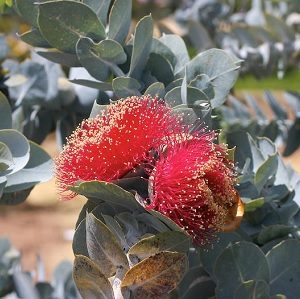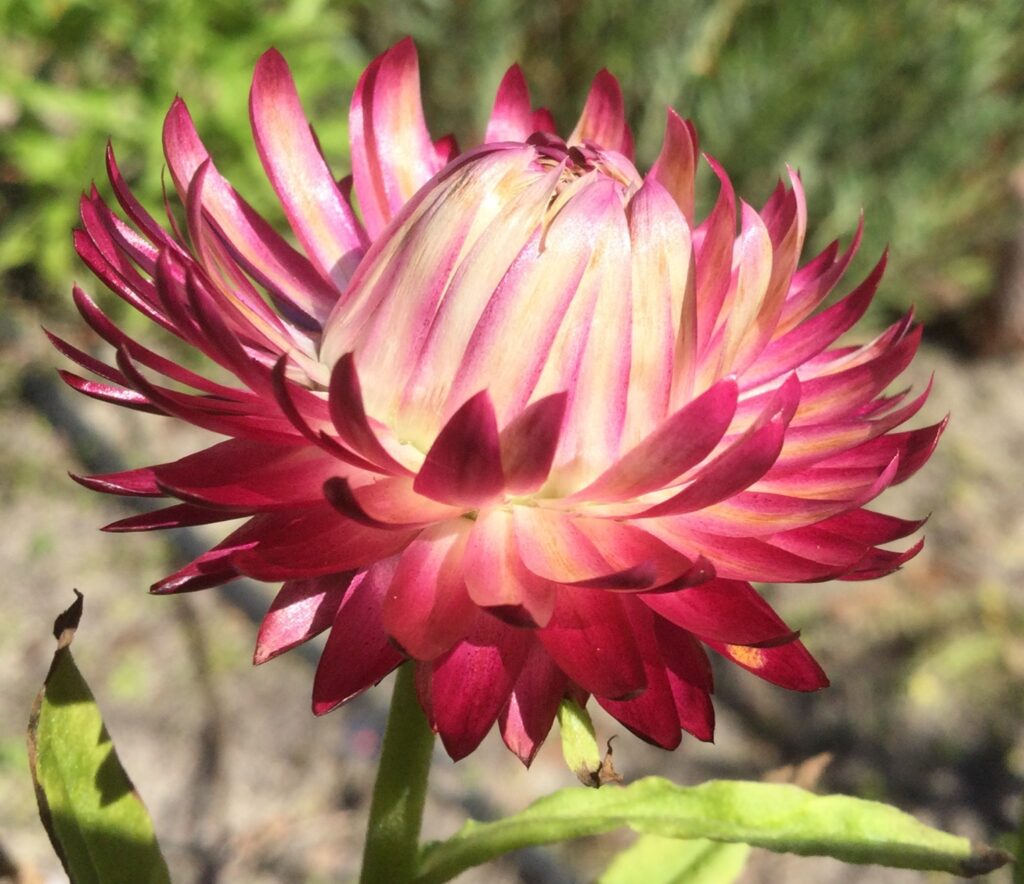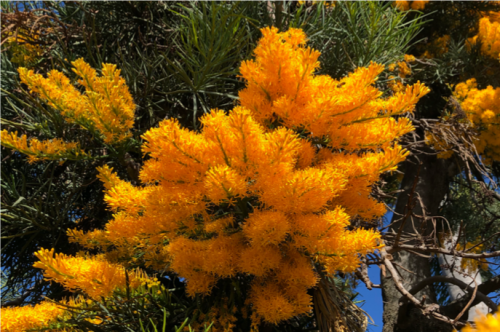GROWING EUCALYPTS FROM SEED
Source: http://www.angelfire.com/bc/eucalyptus/seed.html
(Note: The information in this article relates to experiences in growing Eucalypts in the USA)
Seed propagation is by far the most common way to raise hardy eucs for ornamental purposes. Cuttings are usually very difficult to root, and tissue culture and grafting are seldom used except in forestry operations. So seed is definitely the route to go for most any nurseryman or hobbyist. Eucs are not difficult to raise from seed provided a few simple guidelines are followed.
SEED HARVESTING:
(This step can of course be skipped entirely if you order seed from a seed company.) After eucs flower, seed capsules (or “pods”) develop in the place of the spent flowers. These take a couple months to ripen before the seed inside is viable. When the capsule is ripe, it should be fully developed so that scars are visible on the face of the capsule. These will open to release the seed. The seed is usually very fine and may be brown, black, tan or orange, often with multiple colors coming from the same capsule (and mixed into the same seed packet). (The entire capsule should not be planted.)
Here are four very close-up photos showing examples of Eucalyptus seed. At the upper left is seed of E. cordata, showing the variety in the shapes, colors and sizes that can occur in the seed of a single species. At the upper right isE. paliformis, which has very uniform seed; and at the lower left is E. regnans. The lower right picture (either E. viminalisor E. dalrympleana) shows the difference in size between the seed and seed capsules of eucs. The seed are really quite small.
More examples of Eucalyptus seed capsules: E. urnigera (upper left), E. obliqua (upper right), E. camaldulensis (lower left), and E. globulus ssp. globulus (lower right).
(continued below pictures. . .)
The seed capsules seldom release their seed when humidity is high and temperatures are cool. In order for them to open, they must be kept in a warm, very dry place (most indoor environments will suffice) for several days. If this does not work, the capsules can be put in a microwave for a minute or two. I would caution against microwaving them longer than that, or they may catch on fire. Because of this risk, use only earthenware containers to hold the seed capsules when microwaving – not plastic. Even after this treatment, the seed may need some encouragement to come out of the capsules using a knife or pen tip, if it doesn’t just fall out. Once the seed is out, it can be bagged and stored somewhere cool, and the capsules discarded (although it can be a good idea to keep the capsules in case they are needed to confirm the identity of the parent tree).
When choosing a tree to harvest from, I would strongly suggest making a note of any known provenance information about the parent tree, and recording some of its features, especially if they are noteworthy.
SEED STORAGE:
Any seed not sown immediately upon receipt should be stored in a refrigerator at a temperature of 35 – 40°F. Some species will keep for many years, but there are a few that seem to have a much shorter shelf life. Seed kept in a hot greenhouse can lose its viability in a period of just a few months.
SEED STRATIFICATION:
Seed of many of the hardier Eucalyptus species must be cold-stratified before it will germinate well. Some species will not germinate without stratification, and some will provide a much better germination rate with stratification than without. Many species do not require stratification at all (refer to lists below).
Stratification involves complex chemical processes that I will not go into detail about here. The basic idea behind the whole thing is that the seed must be kept cold and wet for a certain period of time, so that it will “think” it is winter. Once brought back into the warmth again, the seed is more inclined to germinate because it will “think” it is spring. Spring of course is the time of year when plants in general like to start growing, so they can establish as well as possible by the coming winter. The chemical inhibitors that prevent euc seed from being able to germinate at other times of the year (unless stratified) are in place for this reason.
Since there is no easy logical way to tell which species require stratification and which do not, I have compiled a list of the number of weeks for which the seed of each species needs stratification, if it needs it at all. This list has been derived from my own limited experience, and the experience of various seed companies, and will be updated periodically as I find out more. Because the reports of some of my sources and my experience are often contradictory, there are many species I am unsure of. (In any case it would seem that euc seed of some species is not fussy and can be germinated with a variety of treatments. Please share your experience.) When in doubt, I generally tend to err towards a longer stratification period. It usually does not hurt euc seed to be stratified longer than necessary, or to stratify it if it doesn’t need stratification at all.
The grey chart following this paragraph lists stratification times for species that require it. The species that are not listed below do not require stratification. Such species would include
E. acaciiformis, E. angophoroides, E. barberi, E. bridgesiana, E. brookeriana, E. camaldulensis, E. camphora, E. cephalocarpa, E. cinerea, E. cordata, E. dunnii, E. elata, E. goniocalyx, E. gunnii, E, gunnii ssp. archeri, E. kitsoniana, E. leucoxylon, E. macrocarpa, E. mannifera and its subspecies, E. microtheca, E. neglecta, E. nicholii, E. nova-anglica, E. parvula, E. polyanthemos, E. pryoriana, E. pulchella, E. risdonii, E. scoparia, E. urnigera, and E. viminalis.
These species will all give good germination without stratification, provided of course the seed is viable.
In addition to these, there are also some species excluded from the list because they are rare, and I do not know whether they require stratification or not.
STRATIFICATION TECHNIQUES:
The most common way to stratify the seed is to put it in the refrigerator. It must be kept moist at all times and have some air space. Many people have placed the seed between layers of moist paper towel in a plastic bag, but I have found it difficult to maintain the air space in the bag. And if you don’t use a bag, you will likely lose the moisture, which ruins the seed. Another option is to place the already-sown seed, with soil, pots, and all, in the refrigerator. The only drawback to this is that it takes up a lot of precious refrigerator space.
Another alternative is to sow the seed outdoors in the autumn and allow it to undergo stratification naturally from the cool temperatures and wet conditions common to most temperate regions in winter. The seed will then sprout at some point in the spring. It is OK if the seed freezes before it germinates. This technique generally requires less monitoring of the seed to ensure that it is moist, and has the advantage of not taking up any refrigerator space. It is especially effective for species requiring a longer stratification period, such as E. pauciflora and its subspecies, E. cocciferaand especially E. delegatensis.
When you are stratifying, remember to time it so that the seed will be ready to germinate and the plants ready to plant at the desired time of the year.
PLANTING THE SEED:
Eucs are really quite easy to grow from seed compared to a lot of other woody plants and trees, and not all that fussy. The seed sprouts as readily as that of many common annuals and perrenials. It is important to use a light potting mix of relatively neutral pH that will not pack down or get crusty on the top. Beyond that, there is really nothing particularly difficult about it.
The seed should be sown on top of the soil surface, and then covered with a fine layer of sand, just enough to keep the seed from being exposed to the light. (A fine layer of soil can also be used, but the use of sand greatly diminishes the risk of damping off.) Like most other seeds, they need to be kept moist but not wet. Using bottom heat to raise the soil temperature is not necessary, and in fact hinders germination of some of the alpine species. I have had seeds sprout outdoors in March at my home in cool rainy Washington. The ideal germination temperature is around 65°F for the forest species and 60°F for the alpine species. The more tender, showy-flowered species listed on this page from warmer regions of Australia should probably be kept at a temperature of 70°F or so to germinate, and should not be stratified.
It is important that the seedlings be placed in bright light immediately after germination. The seed may be started indoors, but it must be moved outdoors, or into a very sunny window, immediately after they begin to sprout. This can present a difficulty for a hobbyist wishing to start the seed in winter.
NURSERY PRACTICE:
The seed can be sown individually in pots, but since they are so small and rather difficult to handle, I usually sow a large number of seeds in one small (4″ or so) pot. They can then be popped out of the pot all together, separated, and potted up individually. Planting them in larger flats or seed trays also works, so long as your medium is light enough that all the roots come up without breaking off. The time to separate them or prick them out is when the first pair of true leaves (after the cotelydons, which are the first two seedling leaves) have fully expanded and the second is showing. (However it is also OK to wait a little longer than this.) I suggest potting them directly into 1-gallon pots, but smaller pots can also be used so long as they are to be planted out even sooner after that. Do not stake the young trees. The composition of the soil media is not that important; eucs will grow happily in the same media as other woody plants. I suggest that the media should be mixed with the appropriate amount of granular 5-10-10 fertilzer with micronutrients.
(continued below pictures. . .)
A typical example of a Eucalyptus seedling. The first set of leaves, which have now fully expanded, are the cotelydons, and the second set of leaves is starting to develop. The cotelydons may be of a somewhat different shape than this in many species. This picture is magnified almost 2X life size – the seedlings are very small when they first appear.
These seedlings of Eucalyptus vernicosa have been sown in a 4″ pot. A couple sets of leaves are showing, so they are ready to be separated and potted on.
These Eucalyptus perriniana have been sown in a large flat. Although they are very overdue for potting on (3-5 sets of leaves have expanded), they might still make suitable plants if they can be separated without too much root breakage.
Eucs being grown in “D4″ pots – these are about 4″ across and 6″ deep – at Steamboat Island Nursery, Olympia, WA (USA). This picture was taken in late spring and the sides of the greenhouse have been opened up to prevent it from getting too hot.
Eucalyptus glaucescens in a 1-gallon pot. This plant is just slightly larger than would be ideal for planting out or selling.
If they are grown in the spring, they should be ready for planting out (10 – 14″ tall) in about 10 – 18 weeks from when the seed is sown. Plan on about 12 – 14 weeks for most species. This is important to know so that you can have plants ready at the right time of the year. (These time periods do not apply if sowing the seed in the autumn, as noted below.)
If larger plants (16 – 20″ tall) are desired, pot them into 2 gallon pots when they reach about 5 – 6″ tall, taking care to straighten any roots that have reached the edge of the pot and grown sideways. Once they reach about 20 – 24” tall they should be planted immediately, or their growth will be set back. (It may be heartbreaking for the nurseryman to compost trees that get too large, when money could still be made off of them from customers who don’t know any better than to plant large eucs. However I consider this to be the integritous practice in euc growing. Perhaps this means the nurseryman needs to work on promotion so they all sell on time!)
I have mentioned that it is possible to grow eucs somewhat larger and not have problems with their growth being set back (see Eucalyptus growth rate and the importance of planting small). But the buyer (and hopefully the nurseryman/grower) must be cautious about this. One way to encourage the development of a strong root system for the size of the top growth is to use less nitrogen than would be used on most other woody plants. The potted euc should not be staked, and should be very sturdy with a large root system compared to the top of the plant. If it grows into a top-heavy thing that starts to lose a lot of its lower leaves, or if the trunk is weak, then it has grown too large to be suitable for planting.
Their water and temperature needs are relatively undemanding. In most temperate climates, they are grown in a cool greenhouse for late fall, winter, and early spring, and moved out of doors for the rest of the year. Temperature is really surprisingly unimportant; although it affects their growth rate (and temperature control can be a means of adjusting the timing of when the plants are ready), you are likely to get healthy eucs no matter what temperature you grow them at – so long as you don’t let them freeze too hard while in pots. The only quirk to remember with watering is that although many euc species are very drought tolerant once established, they are not very drought tolerant in pots. If they are allowed to dry to the point of wilting, they usually die outright – the leaves cannot be restored and the entire plant often dies.
THE IMPORTANCE OF TIMING:
The seed is commonly sown (or stratifiaction finished) in February or March, so that the plants can be planted out and sold in late spring and early summer. However, I have also had success sowing the seed in early autumn. With the decreasing light levels, they grow much more slowly than they would in the spring. They can then be potted on in the greenhouse at some point over the winter, and be ready to go into the ground in early to mid spring, and thus get very large by the next fall.
If you are raising a large number of eucs to be grown in a cold winter climate where their hardiness will be put to the test, I strongly recommend timing stratification and sowing the seed so that they will be ready to plant in the ground about two weeks before the average date of the last spring frost. Doing so will allow the eucs to establish as well as possible and grow as large as possible before the next winter, so they will be better able to stand up to the cold temperatures. However, if you are willing to take a chance and hope for a mild winter, then it is OK to plant eucs at other times of the year.

DISCOUNT OFFER
GET 50% OFF
While stocks last or until offer is withdrawn


